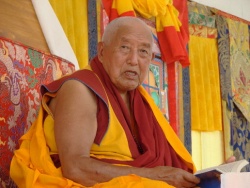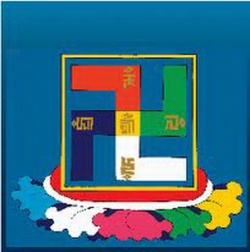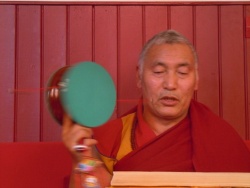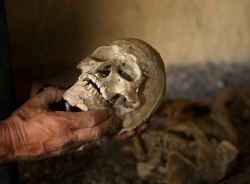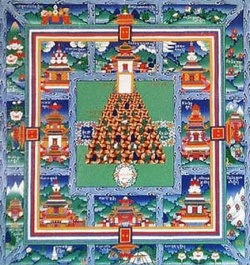Bon
Bon or Bön (Tibetan: བོན་, Wylie: bon [pʰø̃̀(n)]) is a branch of Tibetan Vajrayana. The oral history says Guru Rinpoche incorporated Bon into Tibetan forms along with the Nyingma.
Tradition has three doors to Bon's spread, Tazig 'Olm Lung Ring' as the first. Second, the oral history claims Bon began 17,000 years ago in central Asia where Persia succeeded Bon's widespread growth with Islam. Third, is the Zhang Zhung kingdom which was located in western Tibet. Bon historians hold many [[Wikipedia:Central Asian|Central Asian]] Buddhist antiquities are Bon.
The scholarly history of Bon is difficult to clearly ascertain because the earliest surviving documents referring to the religion come from the 9th and 10th centuries, well after Buddhists began the suppression of indigenous beliefs and practices. Moreover, historian Per Kværne notes that "Bon" is used to describe three distinct traditions:
the pre-Buddhist religious practices of Tibetans that are "imperfectly reconstructed essentially different from Buddhism" and were focused on the personage of a divine king;
a syncretic religion that arose in Tibet during the 10th and 11th centuries, with strong shamanistic and animistic traditions, that is often regarded by scholars as "an unorthodox form of Buddhism;"
"a vast and amorphous body of popular beliefs" including fortune telling.
However, other scholars do not accept the tradition that separates Bon from Buddhism; Christopher Beckwith calls Bon "one of the two types of Tibetan Buddhism" and writes that "despite continuing popular belief in the existence of a non-Buddhist religion known as Bon during the Tibetan Empire period, there is not a shred of evidence to support the idea... Although different in some respects from the other sects, it was already very definitely a form of Buddhism."
Tenzin Gyatso, the 14th Dalai Lama, recognizes the Bon tradition as the sixth principal spiritual school of Tibet, along with the Nyingma, Sakya, Kagyu, Gelug and Jonang schools of Buddhism, despite the long historical competition between the Bon tradition and Buddhism in Tibet.
The syllable -po or -pa is appended to a noun in Tibetan to designate a person who is from that place or performs that action; "Bonpo" thus means a follower of the Bon tradition, "Nyingmapa" a follower of the Nyingma tradition, and so on. (The feminine parallels are -mo and -ma, but these are not generally appended to the names of the Tibetan religious traditions.
History
Foundation
Tradition states that Tönpa Shenrab Miwoche established the Bon religion while searching for a horse stolen by a demon. Tradition also tells that he was born in the land of Tagzig Olmo Lung Ring (considered an axis mundi) which is traditionally identified as Mount Yung-drung Gu-tzeg ("Edifice of Nine Sauvastikas"), possibly Mount Kailash, in western Tibet. Due to the sacredness of Tagzig Olmo Lung Ring and the Mount Kailash, the Bonpo as well as Hindus regard both the swastika and the number nine as auspicious and as of great significance.
Tonpa Shenrab Miwoche visited Kong-po and found people whose practice involved spiritual appeasement with animal sacrifice. He taught them to substitute offerings with symbolic animal forms made from barley flower. He only taught according to the student's capability with lower shamanic vehicles to prepare; until with prayer, diligence, devotion and application they could incarnate to achieve sutra, tantra and Dzogchen.
Bon teachings feature "Nine Vehicles", which are pathway-teaching categories with distinct characteristic, view, practice and result. Medicine, astrology, divination are in the lower vehicles. Then sutra and tantra, with Dzogchen great perfection being the highest. Traditionally, the Nine Vehicles are taught in three versions; as Central, Northern and Southern treasures. The Central treasure is closest to Nyingma Nine Yanas teaching and the Northern treasure is lost. Tenzin Wangyal Rinpoche elaborated the Southern treasure with shamanism.[2]
Competition with Buddhism
After the introduction of Buddhism to Tibet during the 7th century, there was often fierce competition between the two traditions, especially during the reign of Langdarma. Over time, Bon has been losing influence and has been marginalized by the Tibetan political elite.
"A Cavern of Treasures" (mdzod phug)
"A Cavern of Treasures" (Tibetan: མཛོད་ཕུག, Wylie: mdzod phug) is a Bonpo terma uncovered by 'Shenchen Luga' (Tibetan: གཤེན་ཆེན་ཀླུ་དགའ, Wylie: gshen chen klu dga') in the early 11th century.[8] Martin identifies the importance of this scripture for studies of the Zhang-Zhung language:
For students of Tibetan culture in general, the mDzod phug is one of the most intriguing of all Bon scriptures, since it is the only lengthy bilingual work in Zhang-zhung and Tibetan. (Some of the shorter but still significant sources for Zhang-zhung are signalled in Orofino 1990.)
18th century
The Dzungars invaded Tibet in 1717 and deposed and killed a pretender to the position of Dalai Lama who had been promoted by Lhabzang, the titular King of Tibet. This met with widespread approval. However, they soon began to loot the holy places of Lhasa which brought a swift response from Emperor Kangxi in 1718, but his military expedition was annihilated by the Dzungars not far from Lhasa.
Many Nyingmapas and Bonpos were executed and Tibetans visiting Dzungar officials were forced to stick their tongues out so the Dzungars could tell if the person recited constant mantras, which was said to make the tongue black or brown. This allowed them to pick the Nyingmapas and Bonpos, who recited many magic-mantras. A habit of sticking one's tongue out as a mark of respect on greeting someone has remained a Tibetan custom into modern times.
19th century
In the 19th century, Sharza Tashi Gyeltsen, a Bon master whose collected writings comprise eighteen volumes significantly rejuvenated the tradition. His disciple Kagya Khyungtrul Jigmey Namkha trained many practitioners to be learned in not only the Bon religion, but in all Tibetan schools. In modern times, Bon has encountered significant cultural loss. Lately, it has been rejuvenated by the terma tradition.
According to the Bonpo, eighteen enlightened entities will manifest in this æon and Tönpa Shenrab Miwoche, the founder of Bon, is considered the enlightened Buddha of this age (compare yuga and kalpa). The 33rd lineage holder of Menri Monastery, HH the Menri Trizin Lungtog Tenpei Nyima Rinpoche, and Lopön Tenzin Namdak are important current lineage holders of Bon.
More than three hundred Bon monasteries had been established in Tibet prior to Chinese annexation. Of these, Menri Monastery and Yungdrung Monastery were the two principal monastic universities for the study and practice of the Bon knowledge and science-arts.
Bon today
A complex appreciation of Bon is emerging by scholars. Bon, prior to the Tibetan diaspora, existed within a web of ancient indigenous animism, Hinduism, sympathetic magic, Buddhism, folk religion, shamanism, Vajrayana, asceticism and mysticism; complexes prevalent throughout the Himalaya and intermingling throughout the Inner Asian region. Pegg (2006) relates that these
"[c]omplexes include mosaics of performing practices and discourses rather than discrete or fixed sets of practices or beliefs. They are syncretic and overlapping. The power of sound to communicate with spirits is recognized…" and a recurrent motif throughout the region.
Leading Bon scholar Per Kværne writes:
Both Buddhists and Bonpos agree that when Buddhism succeeded in gaining royal patronage in Tibet in the eighth and ninth centuries, Bon suffered a serious setback. By the 11th century, however, an organized religious tradition, styling itself Bon and claiming continuity with the earlier, pre-Buddhist religion, appeared in central Tibet. It is this religion of Bon that has persisted to our own times, absorbing doctrines from the dominant Buddhist religion but always adapting what it learned to its own needs and perspectives. This is ...not just plagiarism, but a dynamic and flexible strategy that has ensured the survival, indeed the vitality, of a religious minority.
Purpose
Among the important aims of Bon are cultivating heartmind with compassionate activity to benefits others. This is to purify and silence the noise of the mindstream within the bodymind, and so reveal rigpa — a transcendent natural bodymind. In rigpa, the obscurations of dualism and dukkha no longer entrance the Bonpo and sambhogakaya and nirmanakaya are aligned in a sympathetic resonance.
Geography
The Bonpa monastery of Narshi Gonpa at Ngawa, Sichuan Province, China.
Ethnic Tibet is not confined culturally to modern political Tibet. The broader area of ethnic Tibet also includes, to the east, parts of the Chinese provinces of Sichuan, Gansu and Yunnan; to the west, the Indian regions of Ladakh, Lahul and Spiti and the Baltistan region of Pakistan; the extreme north-west of Assam; and to the south, Bhutan, Sikkim, and parts of northern Nepal, such as Mustang and Dolpo and the regions in northeastern Nepal inhabited by Sherpa and Tamang people.
Gods of home and hearth
Bonpos cultivate household gods in addition to other deities:
Traditionally in Tibet divine presences or deities would be incorporated into the very construction of the house making it in effect a castle (dzongka) against the malevolent forces outside it. The average Tibetan house would have a number of houses or seats (poe-khang) for the male god (pho-lha) that protects the house. Everyday the man of the house would invoke this god and burn juniper wood and leaves to placate him. In addition the woman of the house would also have a protecting deity (phuk-lha) whose seat could be found within the kitchen usually at the top of the pole that supported the roof.
Historical phases
According to the Bonpos themselves, the Bon religion has actually gone through three distinct phases: Animistic Bon, Yungdrung or Eternal Bon, and New Bon.
Animistic Bon
The first phase of Bon was grounded in animistic and shamanistic practices and corresponds to the general characterization of Bon as described by western scholars.
Initiation rituals and rites closely correlate to the indigenous shamanic traditions of Siberia. Many Bonpo shamans were members of a clan-guild. Shamans were of either gender. A shamanic aspirant was often visited and possessed by an ancestral shaman and/or one or more of any number of entities such as gods, elementals, dæmons, and spirits. The possession typically resulted in a divine madness and a temporary retreat into the wilderness, where the shaman lived like an animal and experienced visions of his own death at the hands of spirits.
After the newly possessed shaman returned, they were taught by senior practitioners and members of the clan-guild how to exert power over the spirits that visited them, as well as incantation of mantra.
Yungdrung Bon
The religion's second era is a contentious phase. It rests on the assertions of the Bonpo texts and traditions, which are extensive and only now being analyzed in the West.
These texts assert that Yungdrung Bon was founded by the Buddha Tönpa Shenrab Miwoche. He discovered the methods of attaining enlightenment and is considered to be a figure analogous to Gautama Buddha. He was said to have lived 18,000 years ago in the land of Olmo Lung Ring, part of the land of Tagzig (see Tagzig Olmo Lung Ring), to the west of present day Tibet (which some scholars identify with the Persian Tajik).
According to Buddhist legend, prior to the manifestation of Shakyamuni Buddha there were numerous other historical Buddhas. Tönpa Shenrab Miwoche transmitted the lore, which was similar in many regards to Buddhism, to the people of Zhangzhung of western Tibet. They had previously been practicing animistic Bon, thus establishing Yungdrung ("eternal") Bon.
Abbot of a Bon Monastery in Nepal - Lopön Tenzin Namdak
One proposition, countered by most Himalayan scholars, is that Buddhism may have arrived in Tibet by a path other than directly from northwest India. A transmission through Persia prior to the 7th century is not improbable as Alexander the Great had connected Greece with India almost a millennium earlier, resulting in a flourishing Greco-Buddhist culture in Afghanistan and Pakistan. Additionally, the 6th century Khosrau I of Persia is known to have ordered the translation of the Buddhist jataka tales into the Persian language. The Silk Road, the path by which Buddhism traveled to China in 67 CE., lies entirely to the west of Tibet and passed through the Persian city of Hamadan. Buddhist structures discovered in far western Tibet have been dated to the 3rd century CE. Bonpo stupas have also been discovered as far west as Afghanistan.
Nonetheless, no scholars have yet identified a major center of Buddhist learning in Persia which corresponds to the Bonpos' land of Tagzig Olmo Lung Ring. Alternative proposed sites have included the ancient cities of Merv, Khotan or Balkh, all of which had thriving Buddhist communities active in the correct timeframe and are located to the west of Tibet.
The existence of the Zhangzhung culture is supported by many lines of evidence, including the existence of a remnant of living Zhangzhung speakers still found in Himachal Pradesh. The claim that Lord Shenrab was born 180 centuries ago is generally not taken literally, but is rather understood as an allusion to a master born in the very distant past.
The elements in Bon that strongly resemble Buddhism became apparent with the codification of the yungdrung Bon canon by the first abbot of Menri Monastery, Nyame Sherab Gyaltsen in the 14th century, but a trend towards this probably began earlier. At the same time, the Nyingma, Kagyu, and Sakya orders of Buddhism were also reorganizing themselves in order to be able to compete effectively with the dominant Gelug order.
Some other events in Tibetan history may mark points at which Buddhist ideas became integrated into Bon.
In the first half of the 7th century, the Tibetan King Songtsen Gampo assassinated King Ligmicha of the Zhangzhung and annexed the Zhangzhung kingdom. The same Songtsen Gampo was also the first Tibetan king to marry a Buddhist (or, in his case, two): in 632, Nepalese princess Bhrikuti, and in 641, Princess Wencheng, daughter of Emperor Tang Taizong of the Tang Dynasty of China where Buddhism was approaching its zenith. The Jokhang Temple, the first Buddhist temple in Tibet, was built in the 7th century to house a Buddhist statue brought by princess Wencheng and to celebrate the marriage.
Approximately 130 years later, King Trisong Detsen (742-797) held a debate contest between Bon priests and Buddhists, and decided to convert to Buddhism; in 779, he invited the great Indian saint Padmasambhava to bring Tantric Buddhism to Tibet. According to Tibetan Buddhist tradition, the arrival of Padmasambhava represents the first transmission of the faith. Tantric Buddhism became important in Tibet at this point.
As tantric Buddhism became the state religion of Tibet, Bon faced persecution, forcing Bonpo masters such as Drenpa Namkha underground. It is possible, however, that several decades later, with the collapse of the Tibetan Empire into civil war in 842, Bon may have experienced a partial revival in some districts, especially in western Tibet.
In the 11th century, approximately coincident with the second transmission of tantric Buddhism into Tibet associated with Indian saints such as Atisha and Naropa, we start to find more Bonpo texts, discovered as terma.
New Bon
The "New Bon" phase began in the 14th century, when some Bon teachers discovered termas related to Padmasambhava. New Bon is primarily practiced in the eastern regions of Amdo and Kham. Although the practices of New Bon vary to some extent from Yungdrung Bon, the practitioners of New Bon still honor the Abbot of Menri Monastery as the leader of their tradition.
Present situation
According to a recent Chinese census, an estimated 10 percent of Tibetans follow Bon. At the time of the communist takeover in Tibet, there were approximately 300 Bon monasteries in Tibet and the rest of western China. According to a recent survey, there are 264 active Bon monasteries, convents, and hermitages.
The present spiritual head of the Bon is Lungtok Tenpa'i Nyima (b. 1929), the thirty-third Abbot of Menri Monastery (destroyed in the Cultural Revolution, but now rebuilt), who now presides over Pal Shen-ten Menri Ling in Dolanji in Himachal Pradesh, India, for the abbacy of which monastery he was selected in 1969.
A number of Bon establishments also exist in Nepal; Triten Norbutse Bonpo Monastery is one on the western outskirts of Kathmandu. Bon's leading monastery is the Menri Monastery in Dolanji, India (Himachal Pradesh).
Much Bon elements are in the Hangui (韩规) religion of Pumi people.
A Taiwan Fengshui master Linyun (林雲) found the Black Sect Tantric Buddhism (密宗黑教) syncretic Bon with Taoist beliefs.
Recognition
Lobsang Yeshe, recognised as the fifth Panchen Lama by the fifth Dalai Lama Lozang Gyatso, was a member of the Dru family, an important family of the Bon religion. Under Lozang Gyatso Bon became respected both philosophically and politically. However, the Bonpo remained stigmatised and marginalised until 1977, when they sent representatives to Dharamsala and Tenzin Gyatso, the 14th Dalai Lama, who advised the Tibetan parliament-in-exile, the Assembly of Tibetan People’s Deputies, to accept Bon members.
Since then, Bon has had official recognition of its status as a religious group, with the same rights as the Buddhist schools. This was re-stated in 1987 by the Dalai Lamao also forbade discrimination against the Bonpos, stating that it was both undemocratic and self-defeating. He even donned Bon ritual paraphernalia, emphasizing "the religious equality of the Bon faith."
However, Tibetans still differentiate between Bon and Buddhism, referring to members of the Nyingma, Shakya, Kagyu and Gelug schools as nangpa, meaning "insiders," but to practitioners of Bon as "Bonpo," or even chipa ("outsiders").
In Bon, the five elemental processes of earth, water, fire, air and space are the essential elements of all existent phenomena or skandhas (aggregates) the most subtle enumeration of which are known as the five pure lights. Tenzin Wangyal Rinpoche states:
[P]hysical properties are assigned to the elements: earth is solidity; water is cohesion; fire is temperature; air is motion; and space is the spatial dimension that accommodates the other four active elements. In addition, the elements are correlated to different emotions, temperaments, directions, colors, tastes, body types, illnesses, thinking styles, and character. From the five elements arise the five senses and the five fields of sensual experience; the five negative emotions and the five wisdoms; and the five extensions of the body. They are the five primary pranas or vital energies. They are the constituents of every physical, sensual, mental, and spiritual phenomenon.
The names of the elements are analogous to categorised experiential sensations of the natural world. The names are symbolic and key to their inherent qualities and/or modes of action by analogy. In Bon, the elemental processes are fundamental metaphors for working with external, internal and secret energetic forces. All five elemental processes in their essential purity are inherent in the mindstream and link the trikaya and are aspects of primordial energy.
Reality and chakras
Chakras, as pranic centers of the body, according to the Tibetan Bon tradition, influence the quality of experience, because movement of prana can not be separated from experience. Each of the six major chakras is linked to experiential qualities of one of the six realms of existence.
A modern teacher, Tenzin Wangyal Rinpoche uses a computer analogy: main chakras are like hard drives. Each hard drive has many files. One of the files is always open in each of the chakras, no matter how "closed" that particular chakra may be. What is displayed by the file shapes experience.
The tsa lung practices such as those embodied in Trul Khor lineages open channels so that lung (prana or qi) may move without obstruction. A yogi opens chakras and evokes positive qualities associated with a particular chakra. In the computer analogy, the screen is cleared and a file is called up that contains positive, supportive qualities. A seed syllable (Sanskrit: bija) is used both as a password that evokes the positive quality and the armor that sustains the quality.
The goals of tantric practice include the eventual transformation of all experience into bliss, and the liberation from negative conditioning, leading to control over perception and cognition.
